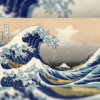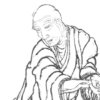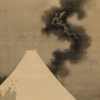Yokoyama Taikan
| NAME | Yokoyama Taikan / 横山大観 |
| BIRTH & DEATH | 1868-1958 |
| BIRTHPLACE | Ibaraki pref. |
| PEN NAME | 大観, 鉦皷洞 |
| MASTER | Hashimoto Gahō, Okakura Tenshin |
| POSITION |
|
| RECORD OF AWARDS |
, etc |
| NOTE |
DESCRIPTION
Yokoyama Taikan (横山大観, 1868-1958) was a Japanese-style painter. He was a great master of the Japanese art world. Teishitsu Gigeiin (Imperial art expert). Received the first Bunka Kunsho (Order of Culture) in 1937.
Born in Mito city, Ibaraki pref.; worked in Tokyo. His family had long been vassals of the Tokugawa daimyo of Mito; as an artist, took his mother’s family name Yokoyama. With his family, he moved to Tokyo in 1878. He studied at the Tokyo Furitsu Daiichi Chugakko (Hibiya High School), and was interested in the English language and in western style oil painting. This led him to study pencil drawing with a painter, Watanabe Fumisaburō. He also studied under one of the great painters of the time, Kanō Hōgai , who was the master of the Kanō school.
Pupil of Hashimoto Gahō and Okakura Tenshin. From 1889 to 1893 studied at the Tokyo School of Fine Arts. In 1895 taught at the Kyoto-shiritsu Bijutsu Kogei Gakko (Kyoto City Specialist School of Arts and Crafts); from 1897 to 1898 professor at the Tokyo Bijutsu Gakko (Tokyo School of Fine Arts).
Eventually resigned and, with Shimomura Kanzan and Hishida Shunsō, helped Okakura Tenshin (who had been dismissed from the Tokyo Bijutsu Gakko) found the Nihon Bijutsuin; became a leading figure in that organization. He reestablish the Nihon Bijutsuin with Shimomura Kanzan, Kimura Buzan and others in 1913.
In 1903 to India; in 1904 to Europe and America with Hishida Shunsō; in 1910 to China; in 1930 to Rome.
In 1931 appointed court artist and member of the Imperial art expert; in 1933 received Asahi Culture Prize; in 1937 first recipient of the Bunka Kunsho (Order of Cultural Merit).
Very well known, always independent, a central figure in the campaign to protect and revitalize traditional Japanese painting.
About 1900, with Hishida Shunsō, created the “Mōrōtai (dimness style)”: an abandonment of linear drawing, a painting without contours; much criticized. His eventual style a mixture of Chinese, Japanese, and Western methods; very eclectic and showy, often working in ink alone but also used color in a realistic manner, with large, bold, striking landscapes and figure compositions.
« Back to Index







